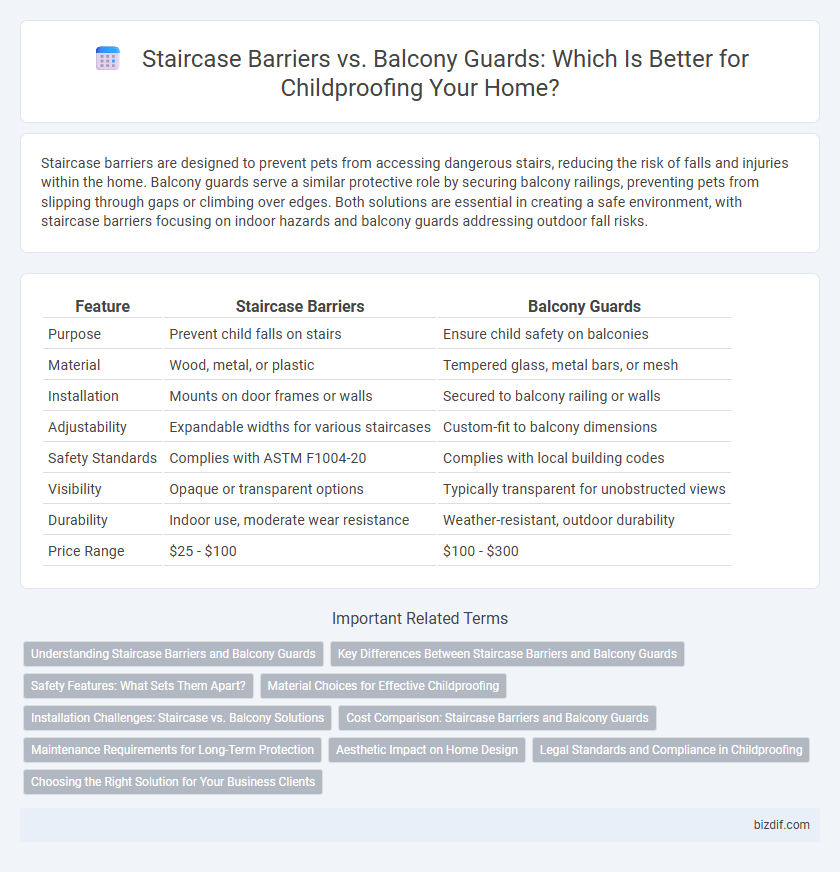Staircase barriers are designed to prevent pets from accessing dangerous stairs, reducing the risk of falls and injuries within the home. Balcony guards serve a similar protective role by securing balcony railings, preventing pets from slipping through gaps or climbing over edges. Both solutions are essential in creating a safe environment, with staircase barriers focusing on indoor hazards and balcony guards addressing outdoor fall risks.
Table of Comparison
| Feature | Staircase Barriers | Balcony Guards |
|---|---|---|
| Purpose | Prevent child falls on stairs | Ensure child safety on balconies |
| Material | Wood, metal, or plastic | Tempered glass, metal bars, or mesh |
| Installation | Mounts on door frames or walls | Secured to balcony railing or walls |
| Adjustability | Expandable widths for various staircases | Custom-fit to balcony dimensions |
| Safety Standards | Complies with ASTM F1004-20 | Complies with local building codes |
| Visibility | Opaque or transparent options | Typically transparent for unobstructed views |
| Durability | Indoor use, moderate wear resistance | Weather-resistant, outdoor durability |
| Price Range | $25 - $100 | $100 - $300 |
Understanding Staircase Barriers and Balcony Guards
Staircase barriers provide a secure physical block to prevent children from accessing stairs, reducing falls and injuries in homes with multi-level layouts. Balcony guards are designed to cover open spaces or railings on balconies, creating a protective barrier to prevent children from slipping through or climbing over. Both options play crucial roles in childproofing by addressing specific hazard zones where accidental falls can occur.
Key Differences Between Staircase Barriers and Balcony Guards
Staircase barriers primarily prevent children from accessing stairs, focusing on height and secure gate mechanisms to block vertical movement, while balcony guards are designed to prevent falls from elevated outdoor spaces with sturdy railings and panels. Staircase barriers often feature pressure-mounted or hardware-mounted gates for indoor use, whereas balcony guards require weather-resistant materials such as metal or tempered glass to withstand external conditions. The critical difference lies in the application environment and safety standards: staircase barriers are tailored for interior stairways, whereas balcony guards must comply with outdoor building codes to ensure fall protection.
Safety Features: What Sets Them Apart?
Staircase barriers and balcony guards are essential childproofing solutions designed to prevent falls, yet they differ significantly in safety features tailored to their specific environments. Staircase barriers typically feature pressure-mounted or hardware-secured designs with vertical slats spaced closely to prevent climbing and ensure they withstand constant use. Balcony guards, meanwhile, emphasize height and stability, often constructed with tempered glass or metal mesh to offer a clear view while preventing children from slipping through or climbing over, addressing the higher risk of severe injury due to balcony heights.
Material Choices for Effective Childproofing
Staircase barriers and balcony guards are essential childproofing tools designed with different material options to ensure safety and durability. Staircase barriers often feature pressure-mounted or hardware-mounted designs made from wood, metal, or durable plastic, providing stability and ease of installation. Balcony guards typically utilize strong metal railings or tempered glass panels to prevent falls while maintaining visibility and aesthetic appeal, making material choice critical for effective childproofing in varying environments.
Installation Challenges: Staircase vs. Balcony Solutions
Staircase barriers require precise fitting to accommodate varied step widths and angles, often demanding custom measurements and secure anchoring to ensure child safety. Balcony guards face challenges related to outdoor exposure, necessitating weather-resistant materials and installation methods that withstand wind and corrosion. Both solutions must comply with safety regulations, but balcony guards typically involve more complex fixing techniques due to structural differences and environmental factors.
Cost Comparison: Staircase Barriers and Balcony Guards
Staircase barriers typically cost between $50 and $150, offering an affordable solution for preventing child access to stairways. Balcony guards range from $100 to $300, reflecting the increased materials and installation complexity required for outdoor safety. Investing in staircase barriers provides cost-effective protection indoors, while balcony guards ensure enhanced security for elevated outdoor spaces.
Maintenance Requirements for Long-Term Protection
Staircase barriers demand regular inspections to ensure hinges and locks function smoothly, preventing accidental openings that could endanger children. Balcony guards require frequent checks for rust, loose fittings, and structural integrity, especially when exposed to weather elements. Consistent maintenance of both barriers and guards is essential to maintain long-term safety and durability in childproofing solutions.
Aesthetic Impact on Home Design
Staircase barriers and balcony guards both enhance child safety but differ significantly in their aesthetic impact on home design. Staircase barriers are often designed to blend seamlessly with interior decor, offering subtle protection without obstructing visual flow. Balcony guards tend to be more prominent, requiring durable materials that may alter the exterior appearance, but modern designs strive to maintain transparency and minimize visual bulk.
Legal Standards and Compliance in Childproofing
Staircase barriers must adhere to stringent legal standards such as the International Building Code (IBC) regulations on guardrail height and spacing to prevent child falls. Balcony guards are governed by similar compliance requirements, including limits on gap widths and materials tested for durability and safety under ASTM F1913 standards. Ensuring both products meet local building codes and child safety laws is essential to mitigate liability and create a secure environment.
Choosing the Right Solution for Your Business Clients
Staircase barriers provide essential protection by preventing young children from accessing hazardous stairways, ensuring safety in multi-level commercial spaces. Balcony guards, designed to secure open ledges, are vital for businesses with elevated outdoor areas where fall risks are high. Selecting the appropriate childproofing solution depends on the specific layout and risk factors of the client's premises, prioritizing compliance with safety standards and tailored protection strategies.
Staircase barriers vs Balcony guards Infographic

 bizdif.com
bizdif.com